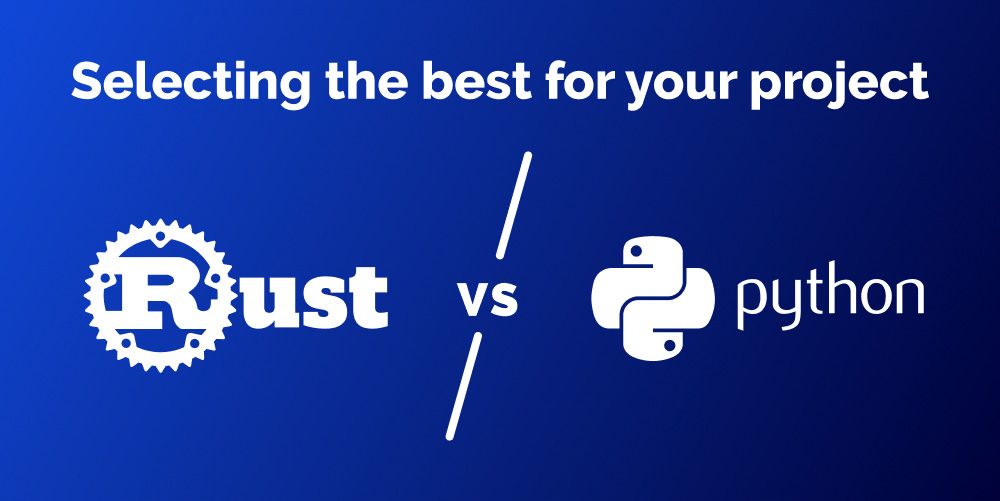Software Development, zBlog
Rust vs Python: Choosing the Right Language for Your Next Project
atif | Updated: March 19, 2025

Programming languages are the backbone of modern software development, and choosing the right one can significantly impact a project’s success. Two popular yet fundamentally different programming languages, Rust and Python, often emerge in discussions about performance, safety, and developer productivity. Each offers unique strengths and is suited to specific types of applications. This blog delves into the features, advantages, and ideal use cases of Rust and Python to help you make an informed decision for your next project.
Understanding Rust

Overview
Rust, created by Mozilla and first released in 2010, is a systems programming language that prioritizes performance, memory safety, and concurrency. It is designed to prevent common programming errors like null pointer dereferencing and data races at compile time.
Key Features
- Memory Safety Without Garbage Collection Rust uses an ownership model with strict compile-time checks, ensuring memory safety without the need for a garbage collector.
- High Performance Rust is comparable to C and C++ in terms of speed, making it ideal for performance-critical applications.
- Concurrency Support Rust’s design prevents data races, making it easier to write safe concurrent code.
- Rich Ecosystem With tools like Cargo for package management and a growing library ecosystem, Rust provides robust support for developers.
Use Cases
- Systems programming (e.g., operating systems, embedded systems)
- Performance-critical applications (e.g., game engines, real-time simulations)
- WebAssembly development
- Blockchain and cryptography solutions
Understanding Python

Overview
Python, created by Guido van Rossum in 1991, is a high-level, interpreted language known for its simplicity and versatility. Its readable syntax and extensive standard library make it a favorite for beginners and experienced developers alike.
Key Features
- Ease of Learning and Use Python’s intuitive syntax reduces the learning curve, enabling developers to focus on problem-solving rather than language intricacies.
- Rich Standard Library Python’s built-in modules support diverse functionalities, from web development to data analysis.
- Extensive Community Support Python boasts one of the largest developer communities, ensuring ample resources, libraries, and frameworks for any project.
- Cross-Platform Compatibility Python code runs seamlessly across multiple platforms without modification.
Use Cases
- Web development (using frameworks like Django and Flask)
- Data analysis and scientific computing (using libraries like NumPy and pandas)
- Machine learning and AI (using TensorFlow and PyTorch)
- Scripting and automation
- Prototyping and rapid application development
Rust vs Python: Feature Comparison

Performance
Rust excels in performance due to its compiled nature and memory safety without garbage collection. Python, being an interpreted language, is slower but compensates with faster development cycles. For applications requiring high computational efficiency, Rust is the better choice.
Safety
Rust offers unmatched safety with its ownership model, preventing common errors at compile time. Python relies on runtime checks, which, while flexible, can lead to runtime errors if not carefully managed.
Concurrency
Concurrency in Rust is safe and efficient, thanks to its ownership rules. Python’s Global Interpreter Lock (GIL) can limit the performance of multithreaded applications, though libraries like asyncio provide alternatives for asynchronous programming.
Developer Productivity
Python’s simplicity and extensive libraries make it ideal for rapid development and prototyping. Rust’s steeper learning curve and verbose syntax may slow down initial development but pay off in long-term reliability.
Ecosystem and Libraries
Python has a mature ecosystem with libraries for nearly every conceivable task. Rust’s ecosystem is growing rapidly, but it is not yet as extensive as Python’s.
Community Support
Python’s large and active community ensures abundant learning resources and third-party tools. Rust’s community, though smaller, is known for being supportive and welcoming to newcomers.
Choosing Between Rust and Python

When to Choose Rust
- Your application requires high performance and low-level control.
- Memory safety and concurrency are critical.
- You’re building embedded systems or other resource-constrained applications.
- The project demands long-term reliability and scalability.
When to Choose Python
- You need to prototype quickly or work on a project with tight deadlines.
- The project involves data science, machine learning, or web development.
- Your team includes developers of varying skill levels.
- Flexibility and ease of use are more important than raw performance.
Rust and Python Together
Interestingly, Rust and Python are not mutually exclusive. They can be used together in projects where their strengths complement each other. For instance:
- Use Python for high-level logic and prototyping.
- Use Rust for performance-critical components.
- Leverage tools like PyO3 to interface between the two languages.
Conclusion: Tailoring the Choice to Your Needs
Choosing between Rust and Python depends on the specific requirements of your project. Rust shines in scenarios demanding high performance and safety, while Python is unbeatable for rapid development and versatility.
At Trantor, we specialize in delivering tailor-made solutions for diverse business needs. Whether you require systems programming expertise with Rust or rapid prototyping and AI solutions using Python, our team of experts is here to assist. Partner with us to harness the full potential of technology and drive your projects to success.




